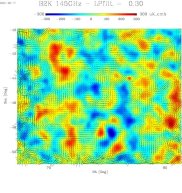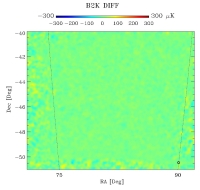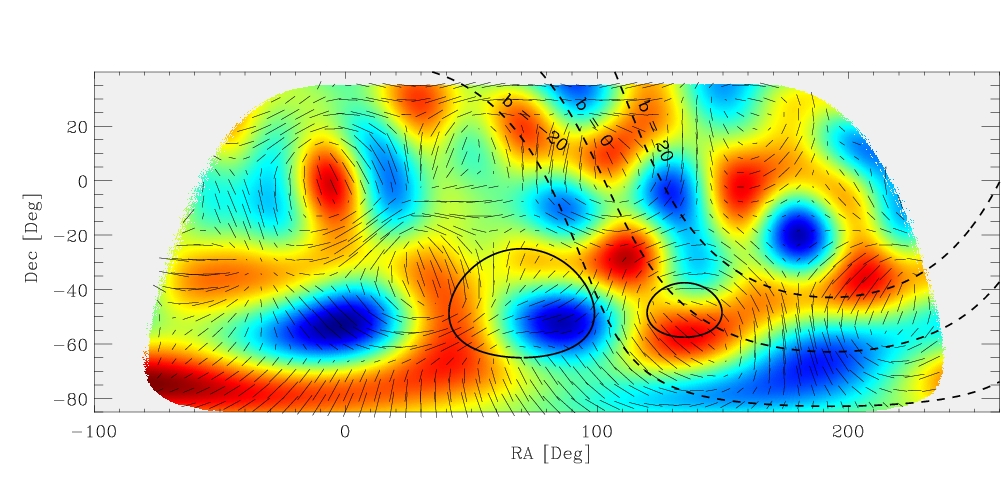


Temperature and polarization anisotropies as seen by Boomerang 2003. The inflight performance of B2K was exceptional, with each 145GHz receiver achieving an NET of 200 uKrts for a single polarization.

A map of the Stokes Q parameter as seen by Boomerang 2003. The color scaling is identical to the temperature plot above, emphasizing the tiny amplitude of the polarized signal.
|
Background
In the past decade, a wealth of data -- much of it from the CMB -- has driven cosmologists to accept a "standard model" of the Universe that has revolutionized physics. The geometry of the Universe is flat, yet the expansion is accelerating, driven by "dark energy" that currently comprises about 2/3 of the total mass-energy density. Baryons make up only 5% of the total, the remainder being in some exotic form of matter. The observational data indicate that the initial density perturbations that seed the structure we see today were primarily adiabatic and nearly scale invariant.
For lack of competition (at least until recent years) a theory called
Inflation has become the default explanation for the root
cause of the flatness of the Universe and of the scale-invariance and
adiabaticity of its density perturbations. (The dark energy remains
anyone's guess). Invented by Alan Guth in the early
1980s as a way to solve the "magnetic monopole" problem,
it was quickly realized that the idea of Inflation could be used to
solve two additional long-standing cosmological puzzles:
- Why is the geometry of the Universe so close to flat, when it
would quickly depart from flatness if it was even slightly curved?
- Why is the temperature of the CMB so uniform over the sky, when
standard models do not causally connect the regions emitting those
photons?
Inflation was the first "physical" model to provide explanations for
these conundrums. It has survived the recent flood of data from the
CMB; the crucial next step is to detect the CGB that would confirm
whether, and perhaps when or how, Inflation happened.
Spider will search for the inflationary CGB with the highest possible sensitivity, and lay the technical and observational foundation for any future orbital mission dedicated to this goal.
The signature of the CGB in the CMB polarization has been discussed
and reviewed by numerous authors [Polnarev (1985), Crittenden (1993),
Kamionkowski Kosowski and Stebbins (1997)]. It can be separated from the more
prosaic form of CMB polarization caused by density fluctuations because that signal has a particular symmetry; it is curl-free. By analogy with electromagnetism, the curl-free component is called the E-mode signal, and the curl component is called the B-mode signal. The inflationary signal is sourced by relic gravitational waves which produce both E-mode and B-mode polarization.
The spatial power spectrum of the E-mode signal is fairly well-predicted
by standard cosmology; recent measurements, including those obtained by Boomerang, have confirmed the expected
amplitude of this signal at angular scales less than a degree.
The amplitude of the B-mode signal is related to the energy scale of
Inflation. If Inflation happened near the
GUT energy scale, then it is likely that its B-mode signature exists at a
detectable level characterized by a tensor-to-scalar ratio r > 0.01.
|




